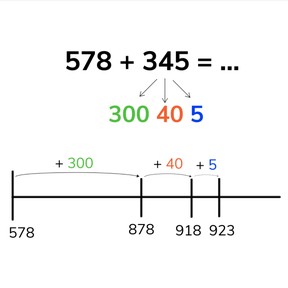



8,000 schools use Gynzy
92,000 teachers use Gynzy
1,600,000 students use Gynzy
General
Students learn to add to 1,000 by splitting the second addend to make it easier to add to the first addend. These addition problems are more challenging as they involve adding to the next place value. For example: 578 + 345 = 923
Common core standard(s)
2.NBT.B.7
Relevance
Discuss with the students that it is useful if you can add by splitting the second addend. By doing so, you make adding larger numbers quicker and easier.
Introduction
Show the addition pyramid on the interactive whiteboard. Point at an addition problem and ask a student to give the total. Erase the squares to show the answer. Ask students to read the story problem and ask them to determine the math problem and to solve for the total. Students can choose from given answers. Ask students how they determined which answer was correct.
Development
Explain to students that they can add by splitting the second addend into hundreds, tens and ones, and add those separately to the first addend. Discuss that a hundred is a group of 100, the tens is a group of ten, and that ones are the numbers 1-9. Next, show how you can add using the number line. You set the first addend at the start of the number line. Discuss that you then add the parts of the second addend in jumps. Show the students which jumps were made on the number line. Ask them which number is shown by the mark on the number line. Make clear to the students that they can choose to also split the tens by first jumping 30 and then 10. By doing so they first add to the round number and then beyond. They can also do this with the ones. Practice an addition problem with the students in which they make jumps of hundreds, tens and ones on the number line. Tell students that they should first add the hundreds, then the tens, and finally the ones, but remind them that they can make their addition easier by splitting the tens into 70 and 20.
Ask students which first steps they should take for different addition problems and ask them to solve. Ask them how they determined their answer.
Check that students are able to add to 1,000 using grouping by asking the following questions:
- Why is it useful to be able to add using grouping?
- What can you do to make it easier to add beyond the tens? (regrouping)
Guided practice
Students first solve an addition problem using the number line. They must add the second addend in jumps. They are then asked to solve by grouping.
Closing
Discuss with students why it is important to be able to add to 1,000 by splitting the second addend because it makes adding larger numbers easier. Students then work in pairs to practice adding on the number line. The first student writes a number at the start of the number line. They then determine a total and take turns jumping in hundreds, tens or ones to reach that total. The pairs are then asked to play memory. The one card has an addition problem, and the second card shows the total to that addition problem.
Teaching tips
Students who have difficulty can make use of the number line. Ask them to draw all the jumps on the number line. Make sure that they know to first jump the hundreds, then the tens, and finally the ones.
Instruction materials
Addition memory: make sets with addition problems to 1,000 on one card, and the total on a second card.
The online teaching platform for interactive whiteboards and displays in schools
Save time building lessons
Manage the classroom more efficiently
Increase student engagement
Discover more!
About Gynzy
Gynzy is an online teaching platform for interactive whiteboards and displays in schools.
With a focus on elementary education, Gynzy’s Whiteboard, digital tools, and activities make it easy for teachers to save time building lessons, increase student engagement, and make classroom management more efficient.



